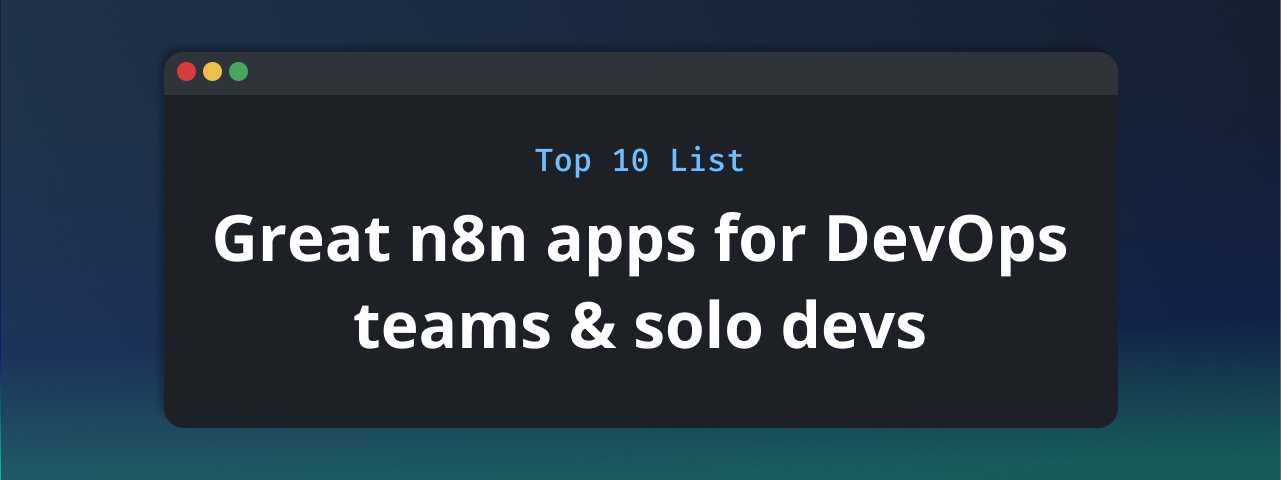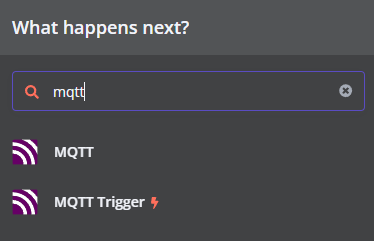10 n8n nodes for DevOps teams and solo network engineers

Automation can make a big difference whether you manage infrastructure, monitor uptime, or handle incident response. The less time you spend on repetitive tasks, the more time you have for work that actually moves things forward.
n8n is an open-source workflow automation platform that connects tools and APIs through a visual interface. It lets you build workflows with a few clicks to automate tasks using your favorite services, be it deployments, monitoring, or reporting.
In this blog post, we'll explore our 10 favorite n8n nodes for DevOps teams and solo network engineers that help make workflows more efficient and reliable.
Send Email
What it is: The Send Email node allows you to send emails directly from your n8n workflows using any SMTP server. It supports plain text and HTML, attachments, CC/BCC recipients, and custom reply-to addresses. It also provides a handy "Send and Wait for Response" action, which pauses your workflow until the recipient replies or approves.
Use cases:
- Send incident notifications when a server goes down by combining it with monitoring tools
- Create deployment approval workflows where stakeholders have to approve before pushing to production
- Schedule daily summaries of system metrics or backup reports
- Combine it with the HTTP Request node to send alerts when your APIs fail
- Use together with GitHub to notify your team about open pull requests
When setting up the Send Email node, you can provide input data from the previous node to send in your email's message:

AWS S3
What it is: Use the AWS S3 node to manage your buckets, files, and folders from n8n. It supports all basic operations such as creating and deleting buckets, uploading and downloading files, and searching within buckets. The node can also handle binary file operations, making it ideal for automating backups.
Use cases:
- Automate database backups by uploading them to S3
- Collect and archive app log files from multiple servers
- Upload build artifacts after successful CI/CD runs
- Combine it with the SSH node to back up configuration files from remote servers
- Pair with HTTP Request to fetch external data before saving it to S3
Globalping
What it is: The Globalping node brings distributed network testing to your n8n workflows. Globalping is an open-source platform for running measurements such as ping, traceroute, dig, HTTP, and mtr from locations around the world. With the node, you can schedule tests from specific regions, automate network monitoring, or combine measurement data with your existing DevOps tools.
Use cases:
- Monitor uptime and latency from multiple locations
- Trigger measurements when an alert goes off
- Compare network performance across locations or ISPs
- Analyze and summarize test results using AI nodes
- Combine with GitHub to test API endpoints after deployments
- Use together with Grafana to visualize global latency and availability metrics
Here, we scheduled a Globalping HTTP test to monitor a website's availability and send the result to a Slack channel:

Grafana
What it is: Grafana is a popular open-source analytics and visualization platform. Using the Grafana n8n node, you can automate dashboard, team, user, and team management. For example, it lets you create, update, delete, and retrieve dashboards and manage access permissions directly from n8n.
Use cases:
- Automatically provision monitoring dashboards for new services
- Create onboarding workflows that add new engineers to relevant Grafana teams
- Build dynamic dashboard management where dashboards update based on deployed services or changed config
- Combine with GitHub to version dashboards
- Pair with Slack to notify teams when critical dashboards are modified
SSH
What it is: The SSH node is a simple yet versatile node for managing remote servers. It supports three operations: executing commands, downloading files, and uploading files.
Use cases:
- Run maintenance and cleanup scripts
- Restart services and check disk space across multiple servers at once
- Build health check systems that run diagnostic commands and report results
- Pair it with Slack to get notifications when a command fails
- Combine with AWS S3 to back up remote server configurations
- Use with HTTP Request to trigger deployments and post-deployment checks
Many nodes require you to set up credentials to connect with. You only need to create them once and then reuse them in all your workflows.

Cloudflare
What it is: The Cloudflare node lets you manage SSL/TLS certificates for your websites. You can automatically upload, view, or delete certificates across your Cloudflare zones. If you want to use additional Cloudflare features, you can use the HTTP Request node to access the Cloudflare API.
Use cases:
- Automatically renew and replace expiring certificates
- Check certificates across multiple domains for security compliance
- Deploy and activate certificates during infrastructure provisioning
- Pair it with Send Email to alert teams when a certificate is about to expire
- Combine with the HTTP Request node to connect to your certificate authority's API
HTTP Request
What it is: The HTTP Request node is one of n8n's most versatile tools, allowing you to make API calls to any service that supports HTTP. So when one of the tools you use doesn't have a dedicated n8n node, you can still integrate it into your automated workflow if it has an API. The node supports all standard HTTP methods, authentication methods, custom headers, and various body formats.
Use cases:
- Check service health endpoints or trigger deployments
- Connect tools that don't have native n8n nodes by chaining API calls
- Create monitoring workflows by collecting status data from multiple endpoints
- Pair with Slack to send API response payloads to your chat
Here, we built a workflow that sends a dog picture from the Dog API to our Slack channel once a day:

Slack
What it is: The Slack node enables you to manage channels, upload files, send messages, and manage users. For example, create and configure channels, post messages, upload files, manage team members, and use most of Slack's messaging features. It also supports setting up automated notifications and workflows that wait for user responses (just like the Send Email node).
Use cases:
- Send deployment and monitoring alerts to team channels
- Create incident response channels, invite team members, and post status updates
- Notify team members until a message is acknowledged
- Pair with GitHub for repository updates
- Combine with Grafana to send dashboard snapshots when alerts trigger
- Integrate with Globalping to post network measurement results to troubleshoot during an incident
MQTT
What it is: With the MQTT node, you can publish messages to specific topics on an MQTT broker. If you want to start a workflow in response to a message received on a subscribed topic, use n8n's MQTT Trigger node instead.
Use cases:
- Send commands to edge devices or sensors
- Publish infrastructure status updates to MQTT dashboards
- Combine with SSH to collect data from servers and publish it to IoT dashboards
- Pair with the HTTP Request node to send API events to MQTT subscribers
- Integrate with monitoring tools to send notifications to MQTT-connected alert systems
Remember to use the MQTT node to send messages and the MQTT Trigger node to initiate your workflow when a message comes in.

GitHub
What it is: Using n8n's GitHub node, you can automate useful repository operations, such as managing files, issues, pull requests, and releases. For example, you can manage repository content, create and comment on issues, handle releases, and trigger GitHub Actions workflows.
Use cases:
- Create issues from monitoring alerts with labels and assignees
- Add comments to existing issues when related incidents occur
- Automate generating changelogs and version tagging after successful deployments
- Keep configuration or documentation files synced across repositories
- Pair with Slack to notify teams about new pull requests or issues
- Use with Grafana to update dashboards stored in version control
Conclusion
n8n gives DevOps teams and network engineers an easy way to connect tools and automate everyday tasks.
We hope you found a few nodes you'd like to try so you can spend less time managing workflows and more time doing the things you really care about.
If you regularly monitor or test network performance, try the Globalping node. It's open source, free to use, and works with many other n8n nodes.